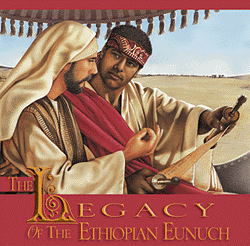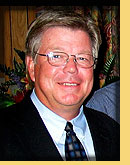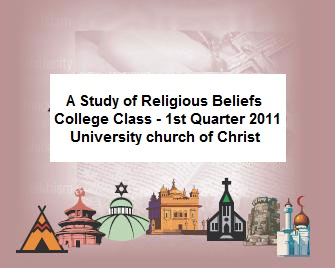Home | About Us | Directions | Bulletins | Sermons & Audio | Cross Of Christ Studies | Classes | Student and Parent Resource Page | Dangers Facing the "Non-Traditional"
Does the Restoration Plea Create Division?
by Mason Harris
Jesus showed his intention to unite men of every nation when he said, “And I, if I am lifted up from the earth, will draw all peoples to Myself” (John 12:32). To this end he said to his apostles,“ Go therefore and make disciples of all the nations, baptizing them in the name of the Father and of the Son and of the Holy Spirit, teaching them to observe all things that I have commanded you” (Matt. 28:19, 20). John explained the purpose of their preaching by saying it was that “you also may have fellowship with us; and truly our fellowship is with the Father and with His Son Jesus Christ” (1 John 1:3). There is a fellowship of men who walk in darkness. But John here speaks of a fellowship with God and fellowship with one another by virtue of the relationship with him. It is a fellowship we have by being drawn to Jesus. When people learn of Christ and are drawn to him, they would be become one with him and with one another. This is illustrated in Acts 2:41-47 where the baptized were added to the church and served the Lord together in this relationship.
Paul spoke of Christ being our peace in that he has reconciled both Jews and Gentiles to God in one body by the cross, thus making peace (Eph. 2:14-16). Peace is the end result of the gospel. Paul could then say to those who accepted Christ, “Now, therefore, you are no longer strangers and foreigners, but fellow citizens with the saints and members of the household of God” (Eph. 2:19).
But there is somewhat of a paradox in this. Jesus said, “Do not think that I came to bring peace on earth. I did not come to bring peace but a sword. For I have come to set a man against his father, a daughter against her mother, and a daughter-in-law against her mother-in-law; and a man’s enemies will be those of his own household” (Matt. 10:34-36). Jesus did not mean to say that the purpose of his coming was to produce discord, but that such would be one of the effects of his coming. Jesus here described the result of his coming as though he had deliberately come to bring that about.
Loyalty to the law of Moses made it difficult for many to see members of their family accept Jesus as the Christ. And no doubt it was much the same way among the pagans when members of their family accepted Christ. It is the same way now with many who are deeply involved in the denominational world. They do not want to see members of their family becoming members of the church of Christ. Jesus knew that sharp differences would arise between those who accept and those who reject him. It was so in the first century. It is so now.
I was asked to write an article under the above title as part of a review of LaGard Smith’s book, Who Is My Brother? My assignment comes from Chapter 2 where Smith quotes from a speaker who used Barton W. Stone and Alexander Campbell to support the view of a fellowship that extends to all believers in Jesus, even though they have not been baptized. As I understand Smith on this point, he was critical of the speaker for his reference to these men and used the latter portion of the chapter to show these men were quoted out of context. Regarding this point, we are in agreement.
For a long time I have been concerned about the danger of some trying to restore the restoration movement with all its imperfections, rather than seeking to restore New Testament Christianity. This reference rekindles my fear. It reminds me of my school days when I was learning to write. Across the top of the chalkboard, and sometimes on my sheet of paper, there was a perfect example of the alphabet as the letters should be written. As line after line was written below the perfect example, the writing looked less like the original as I progressed down the page. Why? Because as I wrote each new line, I was looking at the imperfect example just above, and not at the perfect example at the top of the page. The restoration leaders of the 19th century did a wonderful work as they worked their way out of the denominational world that grew out of the reformation in Europe. But the perfect pattern for us to follow is the New Testament. While we might like to speak in defense of Stone or Campbell, it is not important to our work to know what they said or meant. Our concern must always be: What does the Bible say? We do not have to live with any mistakes that may have been made by any person in restoration history.
When some of the restoration leaders advocated a return to the New Testament and that alone as their rule of faith and practice, they showed their willingness to stand apart from the mainstream of religious thinking. It appears to have been with great agony that they went against family beliefs and long standing practices in the churches where they were members. They did not want the discord that resulted from preaching the gospel, but their preaching called for a separation of those who would follow the Bible only from those who were wedded to the creeds of men. Being often alienated from family and friends because of their choice, they longed for unity among those who were of the same mind. That the lines of fellowship were sometimes breached only shows the weakness of man and should not serve as examples worthy of imitation.
Does the restoration plea create division? This might lead us to ask another question, “Does the restoration plea result in the preaching of the gospel?” If so, then the restoration plea creates division in the same way the preaching of the gospel created division in the first century. It divides the believers from the unbelievers, the obedient from the disobedient. Yes, it often severs the fellowship of families. But know this: It is the ignorance and/or the rebellion of man that causes the hostility and division, and not the gospel of Christ. But in the same way that unity came out of the preaching of the gospel in the first century, the plea to speak where the Bible speaks and to remain silent where the Bible is silent will produce unity now among those who follow it. This will not be because it is a part of restoration history, but because it will be doing all things “in the name of the Lord” (Col. 3:17).
I am indebted to the leaders in the restoration movement, as well as to the courageous reformers before them, who sacrificed so much in providing me with such a background of religious instruction as I have. I read their material with gratitude and profit. But I recognize them as uninspired men, subject to mistakes as all men are. I see them as men pointing me to Jesus and to his word — the perfect way. -- Guardian of Truth --- October, 2000
Other Articles
That Day and This
Real Men
Preach Christ and Not a Plan
![]() Would you like
others to read this article?
Would you like
others to read this article?







